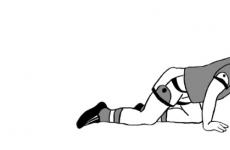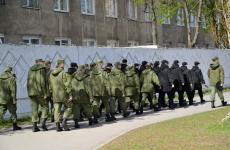Air-cooled chiller with remote condenser. What are Air Condensed Chillers
Large spaces such as entertainment or shopping centers, hospitals, hotels, manufacturing plants and warehouses need a special air conditioning system. It should be closely related to the operation of heating and ventilation systems, and at the same time it is desirable that it not only cool the air, but also humidify or dehumidify it, depending on the characteristics of the building. And air conditioning systems built on the basis of chillers are best able to cope with such tasks today.
What gives such a system?
chiller- or a special refrigeration station - considered one of the most efficient types of climate control equipment, which allows you to create optimal temperature and humidity conditions in any room. Her main function- water cooling, after which pumping units transport cold water pipelines inside the building. At the same time, chillers can be very diverse, but a system built on their basis always has a lot of advantages:
- she gives the most efficient cooling(or heating if needed)
- it is economical- chillers do not consume too much electricity compared to other types of climate control equipment,
- she is not too expensive o - the user will spend the most only when he develops the air conditioning system - this is the most energy-intensive part of the entire project, but it will quickly pay off,
- she multi-variant- depending on the needs of the building and its inhabitants, you can choose the most different types equipment equipped with a whole range of special elements.
What are chillers?
On sale meet different variants of these units, but only 6 varieties are considered the main ones.
1.  Chiller equipped with air-cooled condenser.
Chiller equipped with air-cooled condenser.
As a rule, such equipment operates on water, which acts as a coolant. This option is considered very economical and at the same time easy in terms of design and subsequent installation, however, chillers with air-cooled also have a number of disadvantages. Among them:
- the ability to work only at a positive temperature,
- no adjustment high level sound pressure(its readings often go over 62 dBA),
- the possibility of complete defrosting of the chiller if the water was not drained completely or at the wrong time.
2.  Chiller equipped with air-cooled condenser in outdoor installation and working with anti-freeze liquids.
Chiller equipped with air-cooled condenser in outdoor installation and working with anti-freeze liquids.
As a rule, glycol acts as a heat exchanger and coolant in this situation, but it can also be water. Such a refrigeration station operates on a schedule of 5/10 degrees, and the chilled water after the heat exchanger is 7/12 degrees.
The advantages of this system are:
- the user does not need to empty the hydraulic system every season and then refill it,
- the chiller evaporator never defrosts,
- the system is able to work even at negative outside temperatures,
- in winter, such a system can be integrated with a dry-cooler for free-cooling.
On the other hand, such chillers also have disadvantages. Among them:
- rather high price (compared to the previous model, they cost about 30% more),
- higher electricity consumption (due to glycol),
- more low temperature coolant,
- the presence of a second hydraulic circuit,
- the need to use additional automation that prevents the heat exchanger from defrosting when the system is first started in winter after a long downtime.
3.  Chiller equipped with built-in cooling tower.
Chiller equipped with built-in cooling tower.
This equipment makes it possible to implement free cooling in cold seasons, and the automation independently selects the optimal mode of operation - cooling tower only operation, compressor operation only, or mixed mode. This allows to achieve maximum energy savings, which makes such a system very economical and allows the user to quickly recoup the cost of it.
Another advantage of this option is that a refrigeration station equipped with this equipment can be used without intermediate heat exchangers.
4.  Chiller equipped with a remote condenser.
Chiller equipped with a remote condenser.
The system can serve effectively in certain conditions, but in most cases of operation it will be characterized only by disadvantages:
- such a chiller costs 30-40% more than the first variety,
- the system cannot work all year round in regions with cold climates,
- free cooling can only be achieved if the system works exclusively for this function,
- there should be a small distance between the chiller and the condenser, not exceeding 30 m,
- the system contains too much freon,
- to install such a chiller, only professionals with the highest qualifications will be required.
5.  Chiller equipped with a liquid-cooled condenser function, as well as a dry cooler.
Chiller equipped with a liquid-cooled condenser function, as well as a dry cooler.
The equipment is considered expensive, but it has many advantages:
- this chiller has a high energy efficiency,
- the threat of plant defrosting is completely absent,
- the system can work all year round, withstanding temperatures up to -40 degrees,
- the chiller runs almost silently,
- the system is secure,
- equipment can be installed on the roof, and the load on the roof will be minimal,
- With minimal cost optional free cooling function can be set,
- distance between chiller and cooling tower can be unlimited,
- the chiller does not require complex seasonal maintenance.
However, this technique will be about 60% more expensive than the first option.
6.  Centrifugal chiller or water-cooled station with a centrifugal type compressor.
Centrifugal chiller or water-cooled station with a centrifugal type compressor.
The equipment is considered very efficient, and the lower the temperature of the coolant, the higher the efficiency of the chiller. In order to increase it further, you can use an evaporative cooling tower, which will maintain the water temperature at 30 degrees. This option is perfect for large buildings that need high-power systems.
At the same time, one more thing should be noted important advantage such a system - the capital costs for it are small. But, on the other hand, there are also disadvantages - the cooling water circuit in such a chiller must be constantly fed, and the minimum equipment performance will actually be 30% of the nominal value.
7.  Absorption gas chiller equipped with water cooling function.
Absorption gas chiller equipped with water cooling function.
As a fuel for this equipment, liquefied gas can be used - imported or obtained from a gas pipeline (to install such a chiller, a reliable connection must be made to the gas pipeline). Also, this type of refrigeration system should be completed with an evaporative cooling tower.
If the equipment is connected correctly, it will show excellent benefits:
- minimum relative cost of consumed energy,
- high payback,
- the ability to generate heat in winter for space heating and hot water supply.
At the same time, capital costs for this type of equipment will be quite high, and the minimum chiller performance will be about 25% of the nominal value. Also, such equipment needs to be replenished with cooling water circuits.
What to choose?
Considering all these options, it is enough just to weigh the pros and cons, and you can roughly imagine which chiller option would suit you. However, the final choice should be made taking into account the specifics of the entire facility and your personal wishes and requirements. In particular, you will need to take into account:

- cost and basic electricity costs,
- the price of connection of additional electrical capacities,
- the price of network natural gas,
- features of the climate in which you live,
- the desired payback period for the equipment,
- the possibility of using an evaporative cooling tower,
- the ability to install a refrigeration station and its elements both inside the building and outside,
- peculiarities performance characteristics stations at partial loads during the year,
- chilled liquid parameters and your requirements for them,
- price Maintenance chiller during the year (price for materials and work of specialists during the year),
- equipment service life.
 For example, if you need to cool a server room, be sure to keep in mind that the cooling capacity of the equipment must be at least 1 thousand kW, the connection cost additional energy will be 1.5 tf. USD / kW, and the minimum outdoor temperature will be up to - 40. At the same time, the equipment will work all year round and around the clock, and gas will not be used.
For example, if you need to cool a server room, be sure to keep in mind that the cooling capacity of the equipment must be at least 1 thousand kW, the connection cost additional energy will be 1.5 tf. USD / kW, and the minimum outdoor temperature will be up to - 40. At the same time, the equipment will work all year round and around the clock, and gas will not be used.
Considering these data, the best option The chiller for the server room will be a free-cooling system (chiller no. 5) or a chiller with an integrated cooling tower (no. 3). The latter will be 20% cheaper when purchased and the former will be more economical afterwards. However, in any situation, all investments in such a system (with the same maintenance cost and the same depreciation) will be 5-7 years, after which they will give excellent savings. But if at the same time you need to connect additional electrical power (at a level of about 100 kW), the first option will definitely be more preferable from an economic point of view.
Similarly, chillers should be selected for any other rooms. And only after spending everything accurate calculations and comparing technical task with different types of stations that you could choose from, you will be able to find the optimal climate technology.
According to the principle of operation and obtaining cold, chillers can be divided into two types: vapor compression and absorption. The scope of both types of refrigeration machines is similar. Both types are mainly used for the production of coolant (coolant) for the needs of air conditioning, industrial refrigeration, ventilation or technology. In addition, chillers can also be used to heat the coolant for heating and ventilation needs. Moreover, steam-compression-type units are used for heating much less frequently than absorption units due to their low efficiency at negative ambient temperatures. In this article, vapor compression type chillers will be considered.
Principle of operation.
The main elements of a vapor compression chiller are a compressor, an evaporator, a condenser, and a throttling device. The removal of heat energy in a vapor-compression refrigeration machine occurs due to a change in the state of aggregation of the substance (refrigerant). As a rule, refrigerants are fluorine- and chlorine-containing derivatives of saturated hydrocarbons (mainly methane and ethane). The chiller is running following principle: the compressor pumps the gaseous refrigerant into the condenser (see the diagram in Fig. 1), where as a result high pressure and heat removal, freon gas is condensed. Further, when the liquid refrigerant passes through the throttling device, its pressure drops, while part of the liquid is converted into vapor. This process is accompanied by a decrease in its temperature. Then the vapor-liquid mixture enters the evaporator, where it boils and finally turns into steam. The evaporator is an intermediate freon/water heat exchanger in which heat is transferred from the refrigerant to the liquid to be cooled. Then the liquid of the required temperature is supplied through the hydraulic circuit to consumers - fan coil units, ventilation units, etc.
Rice. 1
Chiller classification.
Vapor compression chillers can be classified:
- by type of condenser cooling;
- air-cooled condenser;
- water-cooled condenser;
- for installation outside buildings;
- for installation inside buildings;
- with free cooling system (freecooling);
- with centrifugal condenser cooling fan;
- by type of compressor, etc.
Condenser cooling method:
- air cooled chillers;
- water-cooled chillers (water-cooled).
Outdoor chillers include air-cooled monobloc chillers that are typically installed on the roof of buildings or in special areas near buildings served. Also, chillers with a remote evaporator can be attributed to outdoor chillers.
To chillers indoor installation relate:
- chillers with a remote condenser (non-condensing);
- water-cooled chillers (water-to-water chillers);
- air-cooled chillers with centrifugal fan.
Chillers of internal installation are located in special rooms - machine rooms. Due to the ease of installation, ease of use and price, air-cooled monoblock chillers are most widely used.
Monobloc air-cooled chillers
Monoblock chillers with are widely used in central air conditioning systems with supply units and in chiller-fan coil systems. Monoblocks have two modifications:
- with axial fans;
- with centrifugal fans (for installation inside buildings).
Chillers with axial fans(Fig. 2) are units mounted on a frame in a single housing and installed on the roof of buildings or nearby on a prepared site. Heat is released to the environment.

Rice. 2
Water or aqueous glycol solutions are used as a heat carrier for operation. refrigeration machine during the cold season. If the requirements of the project do not allow the use of glycols, then an intermediate heat exchanger is built into the system (Fig. 3). With this scheme, the temperature parameters of the glycol solution in the chiller must be 2ºС lower than the calculated temperature in the consumer circuit. For example, in order to ensure the temperature parameters of the water in the intermediate heat exchanger outlet / inlet: 7/12ºC, it is necessary to obtain a glycol solution at the outlet of the chiller with a temperature of 5ºC.

Rice. 3
In addition, when using an intermediate heat exchanger, it is possible to operate the chiller at negative ambient temperatures. The main advantages of air-cooled monoblock chillers are ease of installation, ease of maintenance, complete readiness of the units for operation (charged with refrigerant and oil), relatively low price. Additional advantages of monoblocks include wide possibilities for placement due to the unlimited length of coolant routes and the height difference between the chiller and consumers. Chillers of a modular design also have undeniable advantages:
- minimum delivery time due to stock availability;
- cost savings - the system is put into operation in parts as needed;
- variability - by combining modules of different capacities, we obtain a refrigerating machine of the required power (diagram Fig. 4);
- energy savings - the system operates at the same power level, which in this moment required by consumers by enabling/disabling individual modules.

Rice. 4
Chillers with centrifugal fans(Fig. 5) are intended for installation in premises: basements, attics, office special premises. The main difference from chillers with axial fans is the presence of high pressure centrifugal fan/s. Through a network of air ducts, the fan blows air, which cools the condenser and then is removed outside, and the heat is discharged into the environment.
Advantage of chillers with centrifugal fans:
- long service life due to the location in a heated room.

Rice. 5
Air is taken from the room, blowing can be organized through air ducts in one of three directions (Fig. 6)

Hydromodule. The circulation of the coolant (water, glycol solution) between the chiller and consumers (fan coil units) is provided by a hydronic module ( pumping station) (Fig. 7, a), Hydromodule includes circulation pump, expansion tank, stop valves, storage tank (buffer tank), control and protection system.
The storage tank (Fig. 4, b) is necessary to increase the capacity of the coolant in the system. The buffer tank allows you to reduce the number of starts of compressors and pumping equipment, thereby increasing the life of refrigeration machines. The buffer tank may not be part of the hydronic module and may be supplied separately.
Chillers with a remote condenser (condenserless) (Fig. 8)
A chiller with a remote condenser is a unit in which all the main elements: compressor, evaporator, throttling device are installed on the same frame in a single housing. At the same time, the chiller itself is designed for indoor installation, and the air-cooled condenser is designed for outdoor use and is installed outside.

Rice. 8
The main advantages of chillers with a remote condenser:
- the possibility of year-round operation using water;
- ease of maintenance at any time of the year;
- high efficiency due to the absence of a glycol circuit and intermediate heat exchangers;
- long service life due to location in a heated room;
- the possibility of using a capacitor in a low-noise or explosion-proof version.
> Refrigeration industry > Liquid chillers > Vactekh chiller options and configurations >
Chillers with remote condenser
Equipment "with remote condenser" used when it is impossible to place equipment with significant heat generation inside the workshop or engine room (for a rough estimate, the heat generation in the condenser (in kW) is 30% higher than the cooling capacity of the chiller (in kW)). The chiller itself is installed in the heated room, and the air-cooled condenser is mounted on the roof, next to the building or on the wall of the building. For some eastern regions of Russia, where the temperature in winter for a long period of time is kept at the level of - 30 ... - 35C, this is the only option for completing water-cooling units with a cooling capacity of more than 50-100 kW. When ordering a chiller with a remote condenser, the customer is supplied with two modules: a refrigeration unit (the chiller itself) and an air-cooled condenser. Depending on the performance of the unit, they are equipped with remote condensers of their own production, manufactured by Searle(England) or HTS(Czech Republic).
If a chiller with a remote condenser is operated in the winter (at an ambient temperature below 0 C), then it is equipped with a winter start-up system, which is a system of bypass valves in the freon circuit, which allows the chiller to turn on after a long stop at a low temperature environment. All valves of the winter start-up system are built into the refrigeration unit during production.
The Russian production company CenterProm-Kholod produces various capacities from 1 to 1000 kW. The assembly of water chillers with a remote condenser takes from 7 to 15 days on order, depending on the capacity and configuration of the chiller, on an advance payment. You can buy a chiller with a remote condenser through an online application.
The price of chillers with a remote condenser
Electronic protection - a time relay, provides for a delay in the operation of low pressure when the pressure in the condenser decreases, which is caused by low outdoor temperature, and not a lack of freon. In this case, the automation system does not identify a temporary decrease in pressure as an accident. After the time has elapsed, the alarm will disappear, the compressor, by means of forcing, will raise the pressure in the chiller system in the remote condenser, and if the relay is triggered by a lack of freon in the system, then the alarm signal will be fixed and the chiller will automatically stop working.


with a remote condenser from a chiller with a built-in condenser (monoblock) is the absence in its body of the final heat exchanger - condenser. For this reason, it is also called a "condenserless" chiller. The condenser itself is present in the design, but is made in the form of a unit mounted separately from the refrigeration machine.
Fundamentally, the operation of non-condensing chillers does not differ from that of monoblock structures, but schematically it looks different (see Fig.): The intermediate coolant (usually water) moves along a looped circuit, passing through a heat exchanger (evaporator) refrigeration unit. There, heat is transferred from the coolant to the refrigerant (freon). Freon evaporation is provided by a system of valves, temperature and pressure sensors, and its circulation is provided by a compressor. This part of the circuit is common to all types of chillers.
In non-condensing chillers, the internal (freon) circuit is only partially located in the housing of the refrigeration unit and has leads for connecting its external part, in which the condenser is located.
The principle of locating the final heat exchanger separately from the main refrigeration equipment helps to significantly increase the cooling capacity of the entire system, without a significant increase in energy costs. A similar effect is achieved by installing capacitors in places of free interaction with the outside atmospheric air - on the roofs of buildings or in open areas near them. Air-cooled condensers are mounted in this way. Liquid-cooled condensers can (and preferably) be installed indoors by moving the heat exchanger of the additional water circuit outside.
Advantages and disadvantages of a chiller with a remote condenser
Compared to a chiller with an integral condenser, a "condenserless" chiller has a lot of positive qualities, namely:
- - a more favorable ratio of refrigeration performance and energy consumption;
- - no need for additional heat removal from the room in which the chiller is located;
- – the possibility of the initial layout of the chiller with condensers various designs, dimensions and power or alteration in a similar way already installed system. In the latter case, there is no need to replace the refrigeration machine;
- - low noise level due to the placement of cooling fans outdoors. This feature also allows using the most economical option of equipping the condenser with axial fans;
- - effective cooling by means of "freecooling" (free cooling without the use of forced airflow) during the cold season;
- - all-weather use with liquid-cooled condensers (with ethylene glycol as a heat carrier in an additional circuit). In the case of cooling with running water, it is possible to permanently obtain hot water(if there is a consumer).
The disadvantages of a chiller with a remote condenser are more often manifested in the following:
- - more complex, and therefore - more expensive installation in comparison with monoblock units;
- - the use of liquid-cooled condensers significantly increases the cost of the entire system;
- — limited length of connecting lines between the chiller and the remote condenser.
- However, the last of the shortcomings is very doubtful, since experienced adjusters know many ways to eliminate it.






